Total U.S. Jewelry Sales Up in July, But Specialty Jewelers’ Sales Off
September 21, 16
While consumer demand for jewelry in the U.S. market remains solid, specialty jewelers are losing market share rapidly. For the second consecutive month, specialty jewelry stores – mostly independents and a few small chains – have posted a decline in sales. Worse, specialty jewelers’ sales last July were very weak, so sales comparisons this year should have been easy. Instead, they dug a deeper hole – their market share decline accelerated in July 2016.
Total sales of fine jewelry and fine watches in the U.S. market rose by 4.1 percent in July 2016 when compared to July 2015, according to preliminary estimates from the U.S. Department of Commerce. This gain was about in line with the solid gains in the past few months.
By category, fine jewelry sales were up about 4.0 percent in July, and fine watch sales rose by 4.1 percent. Watch sales have been outpacing jewelry sales for a number of months, but demand for watches has slowed somewhat, according to both the government survey and our panel of jewelers.
July is not an important month for jewelers. The summer doldrums set in during July, and shoppers simply don’t think about jewelry until November, the beginning of the holiday selling season.
Preliminary July sales gains for specialty jewelers show that they are continuing to lose significant market share to other merchants – mostly multi-line retailers – who sell jewelry. Specialty jewelers, who generate a majority of their business from jewelry sales, posted a decline in sales of 2.2 percent, the second consecutive monthly decline. This is a significant deceleration of sales trends from prior months this year by specialty jewelers.
Other retailers who sell jewelry – mostly multi-line merchants such as Wal-Mart, J.C. Penney, and others – posted a very strong 8.4 percent gain in sales during July.
Our outlook calls for more moderate sales increases – perhaps in the three percent range – over the next few months, primarily because comparisons are much more difficult against solid growth in the second half of last year. Further, as the number of specialty jewelers decline, their aggregate sales levels will continue to diminish or show only modest monthly gains.
Total Jewelry Sales Up 4.1 Percent in July
Total sales, based on preliminary data, of fine jewelry and fine watches in the U.S. market in July 2016 were just under $5.7 billion, according to the Department of Commerce.
Specialty jewelers – These specialty merchants, who derive a majority of their revenues from the sale of fine jewelry and watches, posted a decline in sales of 2.2 percent in July, when compared to the same month a year ago. Specialty jewelers’ sales represent about 40 percent of total U.S. jewelry sales. We note that last month’s (June 2016) preliminary sales decline of 2.2 percent was revised to a smaller loss: 1.7 percent down. These numbers represent a sharp deceleration of jewelry demand at specialty jewelers.
Multi-line merchants – Retailers such as Wal-Mart, Costco, and others who sell jewelry generated an estimated jewelry sales gain of 8.4 percent during the month of July. Jewelry sales through multi-line merchants represent about 60 percent of total U.S. jewelry sales, a number that has been growing for several decades.

Consumer Spending on Jewelry Solid in July
Consumer demand for jewelry has been showing growth, especially over the past several months. July’s solid gain comes on the heels of disappointing June results. Broad-based trends are mostly solid. For example, the U.S. economy appears to be posting moderate, but consistent, growth. Further, employment levels continue to strengthen. We also sense that some diamond promotions are beginning to have a positive impact on consumer demand; in addition, fashion jewelry remains a strong category at multi-line merchants. However, we continue to hear that sales of beads are softening.
The graph below shows year-over-year percent changes in monthly fine jewelry and watch sales in the U.S. market since the beginning of 2015. It is clear that jewelry sales gains posted a nice rebound in July.
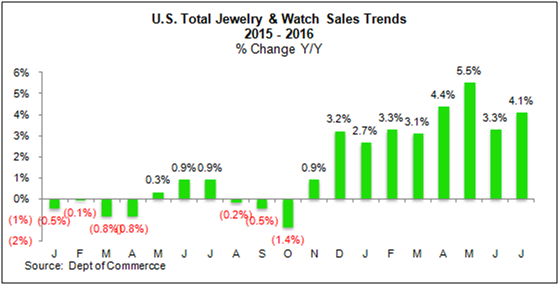
Fine jewelry sales (approximately 88 percent of the market) rose by an estimated 4.0 percent in July, while fine watch sales (approximately 12 percent of the market) were also up by 4.1 percent.
The graph below compares fine jewelry sales gains (red bars) to fine watch sales growth (blue bars). We note that the LGI/NPD Network showed that branded jewelry sales were down11 percent in July and branded watch sales were down 5 percent. Demand for branded goods apparently was soft in July.
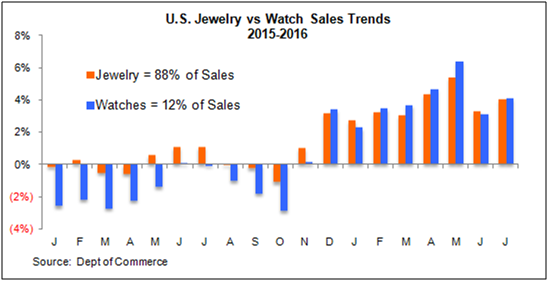
Specialty Jewelers’ Sales Decline in July
Specialty jewelers’ sales during July were an estimated $2.1 billion, a 2.2 percent decline from July 2015, as the graph below illustrates. This monthly sales decline was well below the overall jewelry industry average (all U.S. retailers who sell jewelry) sales gain of +4.1 percent for July. Specialty jewelers’ sales trends are disappointing.
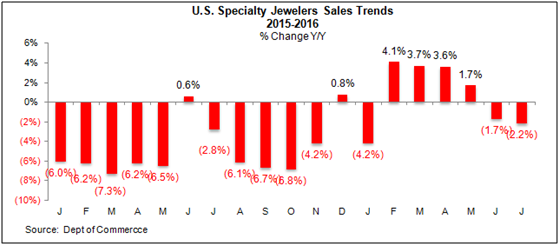
The graph below compares specialty jewelers’ sales trends to multi-line merchants who also sell jewelry. Since June 2015, specialty jewelers (red columns) have lost market share every month, when compared to multi-line retailers of jewelry (blue columns). Specialty jewelers’ market share losses have accelerated in recent months.
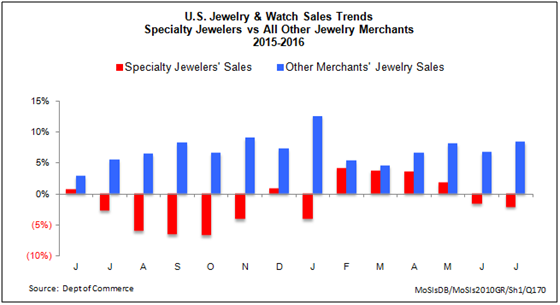
Jewelry’s Share of Wallet Was Up Sharply in July
Total U.S. jewelry sales rose by 4.1 percent in July. This was well ahead of the average retail sales gain (all retail categories) of 0.9 percent posted by all U.S. retail merchants. As a result, the U.S. jewelry industry took share of wallet from other retail merchants.
On the graph below, jewelry sales gains are represented by the red bar; total retail sales gains are represented by the green bar.
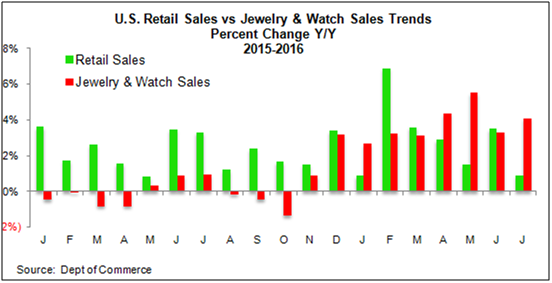
Outlook – We Remain Optimistic
The U.S. retail jewelry sector has been relatively robust since the all-important 2015 November-December period, based on revised data.
Our preliminary sales forecast for the U.S. jewelry industry for 2016 calls for a gain of three percent or greater for the full year. While our full year jewelry sales forecast may seem conservative, year-over-year sales comparisons become more difficult in subsequent months.